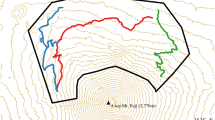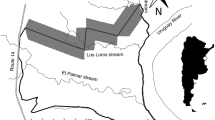Abstract
Chital or axis deer (Axis axis) form fluid groups that change in size temporally and in relation to habitat. Predictions of hypotheses relating animal density, rainfall, habitat structure, and breeding seasonality, to changes in chital group size were assessed simultaneously using multiple regression models of monthly data collected over a 2 yr period in Guindy National Park, in southern India. Over 2,700 detections of chital groups were made during four seasons in three habitats (forest, scrubland and grassland). In scrubland and grassland, chital group size was positively related to animal density, which increased with rainfall. This suggests that in these habitats, chital density increases in relation to food availability, and group sizes increase due to higher encounter rate and fusion of groups. The density of chital in forest was inversely related to rainfall, but positively to the number of fruiting tree species and availability of fallen litter, their forage in this habitat. There was little change in mean group size in the forest, although chital density more than doubled during the dry season and summer. Dispersion of food items or the closed nature of the forest may preclude formation of larger groups. At low densities, group sizes in all three habitats were similar. Group sizes increased with chital density in scrubland and grassland, but more rapidly in the latter—leading to a positive relationship between openness and mean group size at higher densities. It is not clear, however, that this relationship is solely because of the influence of habitat structure. The rutting index (monthly percentage of adult males in hard antler) was positively related to mean group size in forest and scrubland, probably reflecting the increase in group size due to solitary males joining with females during the rut. The fission-fusion system of group formation in chital is thus interactively influenced by several factors. Aspects that need further study, such as interannual variability, are highlighted.
Similar content being viewed by others
References
Barrette C 1991 The size of Axis deer fluid groups in Wilpattu National Park, Sri Lanka;Mammalia 55 207–220
Burnham K P, Anderson D R and Laake J L 1980 Estimation of density from line transect sampling of biological populations;Wildl. Monogr. 72 1–202
Caughley G 1977Analysis of vertebrate populations (Chichester: John Wiley)
Champion H G and Seth S K 1968A revised survey of the forest types of India (Delhi: Manager of Publications, Govt. of India)
Clutton-Brock P H, Albon S D and Harvey P H 1980 Antlers, body size and breeding group size in Cervidae;Nature (London)285 565–567
Clutton-Brock P H and Harvey P H 1978 Mammals, resources and reproductive strategies;Nature (London)273 191–195
Fuchs E R 1977 Behavior; inThe Axis deer in Texas (ed.) E D Abies (Texas: Caesar Kleberg) pp 24–52
Giraldeau L 1988 The stable group and the determinants of foraging group size; inThe ecology of social behaviour (ed.) C M Slobodchikoff (San Diego: Academic Press) pp 33–53
Graf W and Nichols L 1966 The axis deer in Hawaii;J. Bombay Nat. Hist. Soc. 63 629–734
Hamilton W D 1971 Geometry for the selfish herd;J. Theor. Biol. 31 295–311
Jarman P J 1974 The social organisation of antelope in relation to their ecology;Behaviour 48 216–267
Johnsingh A J P 1983 Large mammalian prey-predators in Bandipur;J. Bombay Nat. Hist. Soc. 80 1–57
Johnsingh A J P and Sankar K 1991 Food plants of chital, sambar and cattle on Mundanthurai Plateau, Tamil Nadu, south India;Mammalia 55 57–66
Karanth K U and Sunquist M E 1992 Population stucture, density and biomass of large herbivores in the tropical forests of Nagarahole, India;J. Trop. Ecol. 8 21–35
Khan J A, Chellam R and Johnsingh A J P 1995 Group size and age-sex composition of three major ungulate species in Gir Lion Sanctuary, Gujarat, India;J. Bombay Nat. Hist. Soc. 92 295–302
Khan J A and Vohra U 1992 Group size and group composition of chital (Axis axis) in Gir, Gujarat, India;Mammalia 56 662–665
Krishnan M 1972 An ecological survey of the larger mammals of peninsular India;J. Bombay Nat. Hist. Soc. 69 469–501
Mishra H R 1982The ecology and behaviour of chital (Axis axis) in the Royal Chitwan National Park, Nepal, Ph.D, thesis, Univ. of Edinburgh, Edinburgh, UK
Misra M K and Misra B N 1984 Biomass and primary production in an Indian grassland.Trop. Ecol. 25 239–247
Miura S 1981 Social behaviour of the Axis, deer during the dry season in Guindy sanctuary, Madras;J. Bombay Nat. Hist. Soc. 78 125–138
Miura S 1983 Grouping behaviour of male sika deer in Nara Park, Japan;J. Mammal. Soc. Jpn. 9 279–284
Norušis M J 1990SPSS/PC + Statistics 4.0 (Chicago: SPSS Inc.)
Prasad S N and Sharatchandra H C 1984 Primary production and consumption in the deciduous forest ecosystem of Bandipur in south India;Proc. Indian Acad. Sci. (Plant Sci.)93 83–97
Pulliam H R and Caraco P 1984 Living in groups: Is there an optimal group size?; inBehavioural ecology: An evolutionary approach (eds) H R Pulliam and P Caraco (Oxford: Blackwell) pp 122–147
Puri G S, Gupta R K, Meher-Homji V M and Puri S 1989Forest ecology: Plant form, diversity, communities and succession (New Delhi: Oxford and IBH)
Rajasekhar B 1992 Observations on the vegetation of Guindy National Park; Blackbuck 8(2) 38–42
Raman T R S, Menon R K G and Sukumar R 1996 Ecology and management of chital and blackbuck in Guindy National Park, Madras;J. Bombay Nat. Hist. Soc. 93 178–192
Rodman P S 1988 Resources and group sizes in primates; inThe ecology of social behaviour (ed.) C M Slobodchikoff (San Diego: Academic Press) pp 83–108
Schaller G B 1967 Thedeer and the tiger (Chicago: University of Chicago Press)
Sharatchandra H C and Gadgil M 1975 A year of Bandipur;J. Bombay Nat. Hist. Soc. 72 623–647
Sinclair ARE 1977The African buffalo (Chicago: University of Chicago Press)
Varman K S and Sukumar R 1995 The line transect method for estimating densities of large mammals in a tropical deciduous forest: An evaluation of models and field experiments;J. Biosci. 20 273–287
White G C 1987Program TRANSECT-Line transect data analysis program, Version 2. 1, Utah Cooperative Wildlife Research Unit
Wilson E O 1975Sociobiology: The new synthesis (Cambridge: Belknap Press)
Wittenberger J F 1980 Group size and polygamy in social mammals;Am. Nat. 113 197–222
Author information
Authors and Affiliations
Rights and permissions
About this article
Cite this article
Raman, T.R.S. Factors influencing seasonal and monthly changes in the group size of chital or axis deer in southern India. J. Biosci. 22, 203–218 (1997). https://doi.org/10.1007/BF02704733
Received:
Revised:
Published:
Issue Date:
DOI: https://doi.org/10.1007/BF02704733




